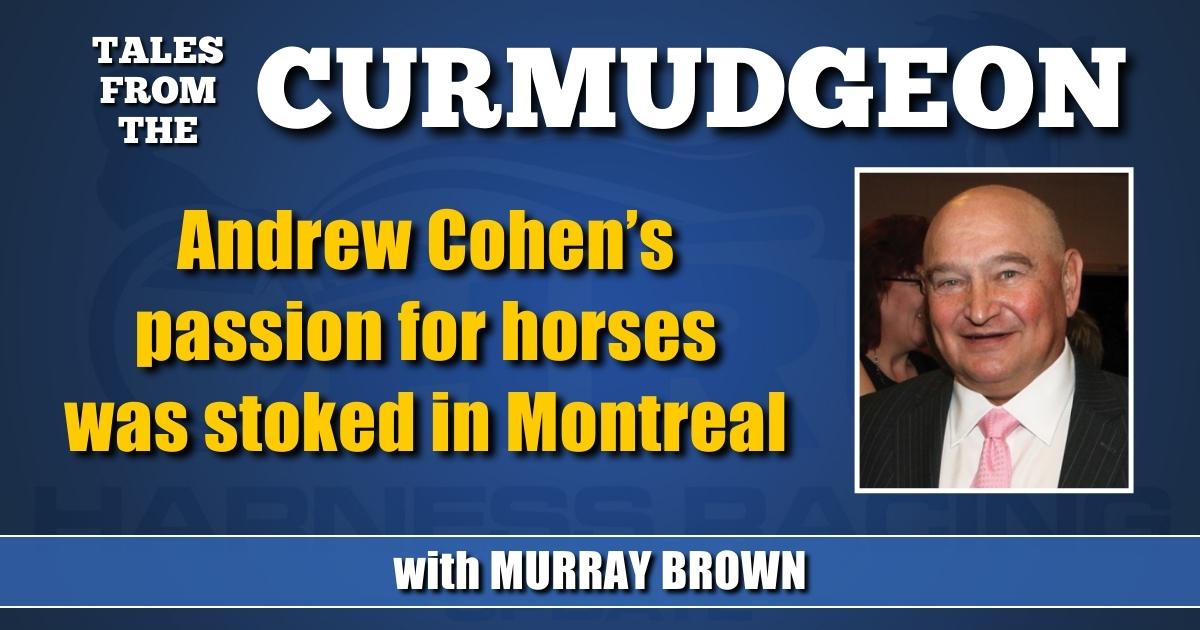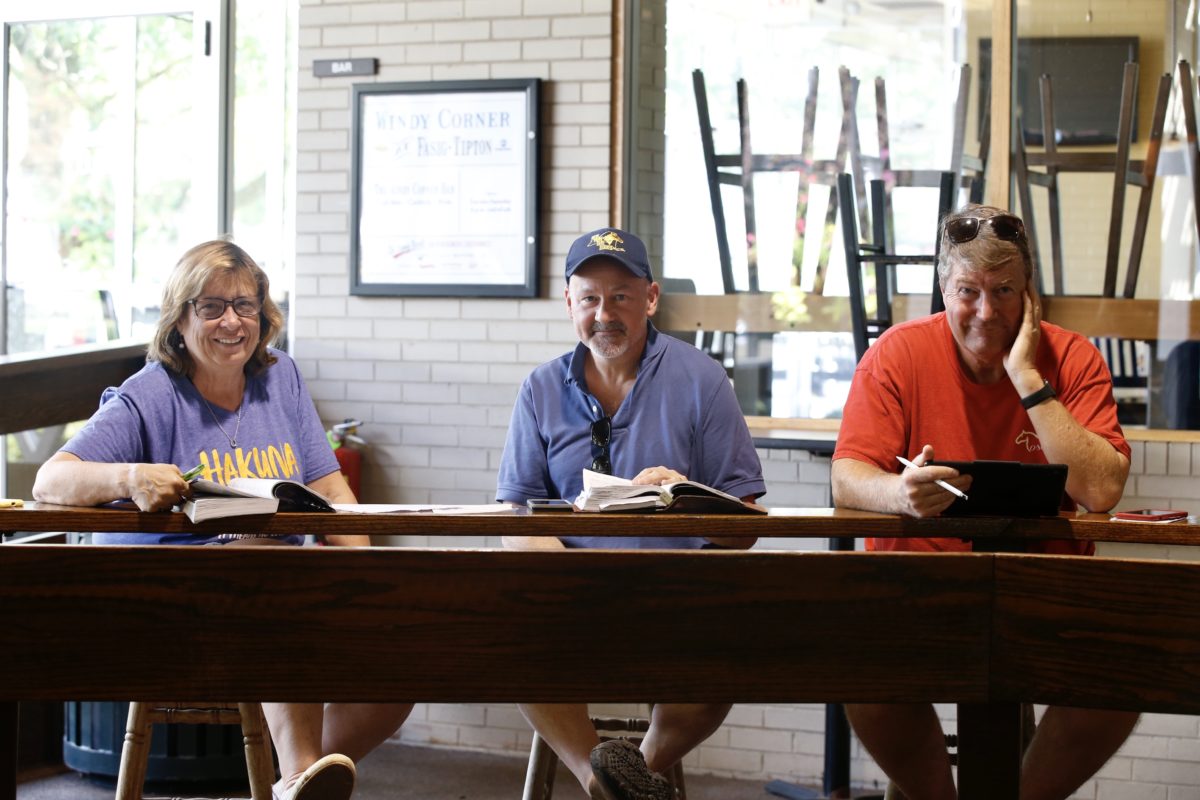Andrew Cohen’s passion for horses was stoked in Montreal
by Murray Brown
Andrew Cohen and yours truly share a lot of interests and history. To wit, we were both born and raised in Montreal, a city to which both of us still feel a great affinity, even though it has been decades since we’ve left. We had no history with horses until we became involved with them. We both came from non-equine backgrounds. We each began our interest in harness racing and primarily its horses through family involvement — Andrew through his father, Eddie Cohen, and myself through my oldest brother Sam. But this story is about Andrew Cohen, not Murray Brown.
Tell us a little about yourself. You’ve now been involved in the sport for about 50 years, with a break of about 25 years as a young adult.
“As you’ve said, I’m from Montreal. I started going to the races at Blue Bonnets, which wasn’t more than a 10-minute drive from our home. My parents went all the time and my dad would take me to the track on Sunday afternoons and to the backstretch every Saturday and Sunday morning. I loved it. My dad became involved because his accountant at the time told him buying horses would have tax benefits. Problem was, the first few horses my dad bought were cheap overnight horses. They all made a little money. So he kept buying those kind. We had horses trained by Denis Normandin, Onil Patry and Pierre Desjardins, but the first trainer I remember well was Peter Litwin, who was a really great guy with whom I am still in touch. He lives in Florida. Peter bought us Wanaque, who was a really nice conditioned pacer, and Silvern Hanover, a classy trotter. My dad eventually wanted to get into the yearling game and so we connected with Duncan MacTavish, the son of Hall of Famer Del MacTavish.
“It was in Duncan’s stable that I really grew to love horses and harness racing. There were so many characters along the backstretch of Blue Bonnets those days and I cannot possibly remember them all. I met Freddie Grant, Herbie Liverman, Gilles Gendron, Michel Lachance, Marcel Dostie, Daniel Jean and Benoit Cote through Duncan. I got to go to Saratoga with my dad and his partner Connie Leber to watch a race in 1978, an experience I will treasure forever. We had some decent yearlings toward the end of the 1970s, including Painter Lobell, who Peter Litwin had picked out, and Caravelle Sam, who Duncan bought in Lexington. Sadly, the best horse my dad owned with Duncan was Safe Arrival, a horse that Duncan bought from Castleton Farms. He ended up earning over $450,000 and taking a record of 1.54.1 but by that time we had moved from Montreal to Colorado so my dad didn’t get the full benefits of that partnership.”
Living in Denver, were you still able to be involved with your horses?
“The short answer is no. I was 13 years old when we moved and there was really no way to follow harness racing from that far away. We read the Harness Horse magazine and the Horsemen and Fair World magazines, which I was privileged to write for decades later. I grew up, went to Boston for college and law school, and began my career as a lawyer and journalist at CBS News. In 2005, as I neared age 40, I realized I needed a good, old-fashioned vice. I didn’t play golf or enjoy wine, cars or travel. I am not a foodie. By that time, my dad was getting ill. So I reached back out to Duncan, with whom I had stayed close through the years. I asked him for advice on how to get back into the game. He told me to call Mike Lachance, our old family friend. Michel and his son Martin helped me pick out a few horses in 2005.
“By 2006 we were back in the game with a nice filly named Wild Ride Hanover and Share The Delight, a colt the Lachances picked out for us in 2006 at Lexington. My best friend, Lorne Polger, whose family also had moved from Montreal to Colorado, was my partner (and still is) and we were, as you could say, off to the races. Share The Delight was a blessing and a curse. He was really fast, finishing third to Somebeachsomewhere and Art Official in the 2008 Meadowlands Pace, a race many people consider one of the greatest ever. We thought: this game is easy. You pick out a yearling for $50,000. It makes $500,000! We now know how hard it is to repeat that scenario. But he was the best horse my dad ever owned and he got to see him race just weeks before he died.”
You’ve been with Linda Toscano since 2007. That’s a pretty long time to be involved with a single trainer in this business.
“I love Linda. Everyone loves Linda. She’s like an older sister to me. My own older sister died seven years ago. I consider Linda and her husband Brad McNinch to be two cherished friends. I rarely get to see them since I live so far away from where they train and race. Reuniting with them in Lexington and Harrisburg is like a family reunion to me. That’s a good way to think of her stable and her owners. Most of us are good friends. Even though we may not be in partnership on a particular horse. We still root for each other all the time. Brad and Linda always put the horse first. Brad’s horsemanship is totally underrated. He is an excellent trainer as well.”
How many horses are you involved with?
“Right now I have parts of eight racehorses and seven broodmares. Mostly pacers but a few trotters. We race at 2 and 3 and then either sell them or turn them into broodmares.”
You mention broodmares. How long have you been involved in the breeding business.
“I love that part of the business, probably more than the racing. We have mares at Cindy and Steve Stewart’s gorgeous Hunterton Farm in Paris, Kentucky, and two with Mark Mullen, who does great work at Fair Winds Farm in New Jersey. I learn something about the sport every single time I talk to Steve. He and Cindy and Mark raise a wonderful horse. My partners would pick the racing over the breeding but I am the opposite. I’d love to end up with a small, sharp broodmare band and go from there.”
Do you have a method or game plan when it comes to buying yearlings?
“I like to be involved with the process. I study the catalogues online and then when they come in print. I’ll mark off the pedigrees that appeal to me and then let Linda and Brad handle the evaluations on conformation. Once in a while I’ll travel to Kentucky or New Jersey or New York to look at yearlings before the sale. Mostly I just see them when they come to Fasig-Tipton or Harrisburg. We never have an unlimited budget so, like most everyone else, we are trying to find value or zig when others are zagging. I am a big fan of the programs in Kentucky and Ontario so this year we tried to shoot for dual-eligibles. By the way, harness racing needs more folks like Trevor Ritchie, who judges conformation of all the horses for Brittany Farm. I would encourage honest trainers and drivers who are good at doing that to consider offering their services each summer/fall. They’d make good money.”
Do you have any favorite breeders with whom you like to deal?
“I love to deal with Hunterton, naturally, and we’ve purchased a few good horses over the years from other farms. It’s getting harder and harder to buy horses at public auctions. So many breeders keep their best horses to race against you. That explains why some prominent owners now are working more on keeping their nice mares and are racing homebreds. I hope we can do more of that in the years to come. I wish breeders and consigners culled fewer of their horses. I don’t have to tell you, Murray, that there’s a lot that goes on behind the scenes at these sales that owners never know about.”
How about preferences — colts or fillies, trotters or pacers?
“Fillies, I guess. Linda loves her fillies. But I want to win some of the classics before I die, So I am always looking for a good colt… I always like to try at least one trotter each year.”
You’ve recently been quite vocal about the United States Trotting Association and the manner in which it is managed. Would you care to elaborate?
“The staff and employees of the USTA do a wonderful job. The website is invaluable. The ‘members services’ folks who make it run are excellent, willing and capable people. I cannot remember a situation where I didn’t come away from contact with them not satisfied with how it went. We are lucky to have a breed registry that services its members in that way. In that sense, it’s a well-run organization.
“The USTA’s leadership, on the other hand, is a disaster. The Board of Directors is way too large and totally unaccountable to its members. I can’t remember the last time my representative asked me (or any other members) for guidance on the contentious issues the USTA faces and the bylaws are, what, 100 times longer than the U.S. Constitution? The USTA makes it way too hard for members to run for office or for directors to be removed from office. The best example of this is a recent one. Everyone in harness racing, including Russell Williams and Joe Faraldo, know that there is great disagreement over the new federal racing integrity law, HISA. Everyone knows this because last year about 300 of the most prominent people in the sport declared their opposition to the way Williams and Faraldo were handling the HISA situation. So what did the USTA just do? Did it reach out to members to ask for opinions? No. Did it encourage an honest debate about HISA? No. Did it seek compromise? No. Instead, USTA members got more anti-HISA propaganda and the USTA just doubled down on a losing bet. Without asking its members first it just approved another $500,000 in legal fees to continue to fight a losing lawsuit against the federal law.
“There was no membership vote on approving such an expense. I don’t even think there was a board of directors’ vote. Instead, the Executive Committee, during Jug Week, quickly endorsed the expense. It’s a bad move as a legal matter. Don’t directors have fiduciary duties to members? It presents terrible optics as a matter of politics, saying to the world: ‘Hey, we are the breed that doesn’t want to change the status quo to better catch the cheaters which we all know are in our sport.’ But it’s also a terrible decision as a practical matter because by suing the HISA entity the USTA now is precluded from negotiating with HISA officials to try to gain concessions from federal regulators.
“Williams and Faraldo are leading the USTA over a cliff and the USTA’s board seems unwilling to stop them. Hopefully, the rest of us will figure out a way to jump off the wagon in time to fix HISA so that it works for harness racing in the years to come. If we don’t we’ll lose purse subsidies and racing as we know it will end in many places.”
Have a question or comment for The Curmudgeon? Reach him by email at: hofmurray@aol.com


















